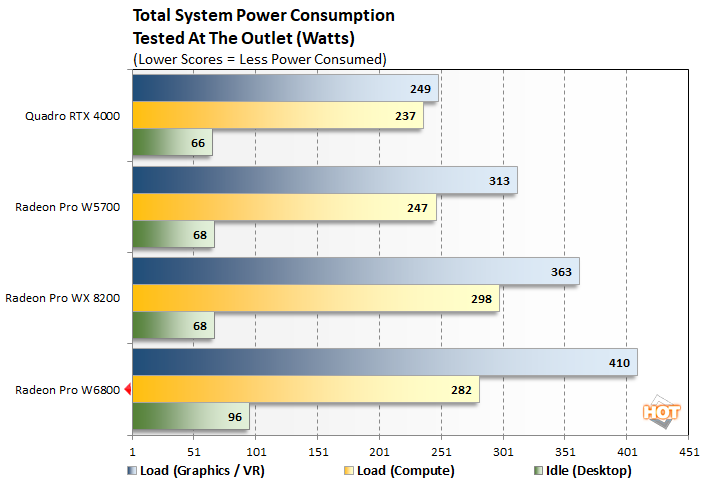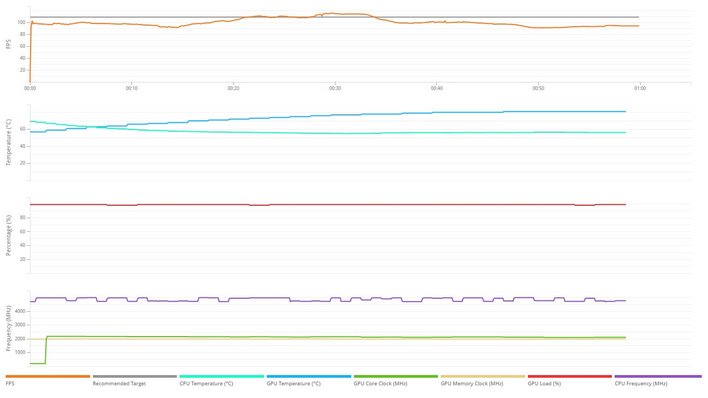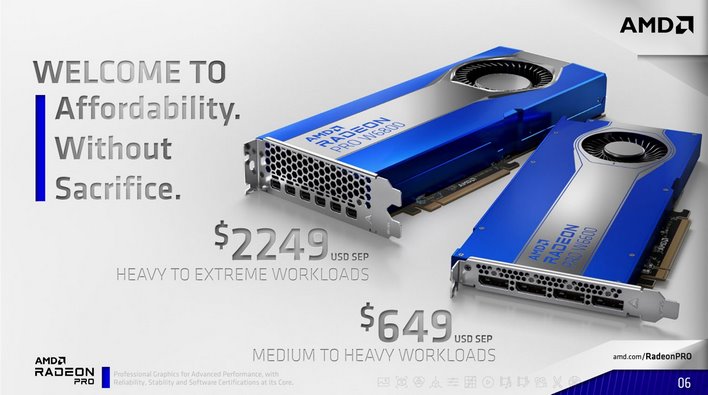Radeon Pro W6800 Review: AMD RDNA 2-Infused Workstation Muscle
AMD Radeon Pro W6800: Power Consumption, Acoustics And The Verdict
Before bringing this article to a close, we'd like to cover a couple of final data points -- namely, power consumption and noise. Throughout all of our benchmarking and testing, we monitored acoustics and tracked how much power our test system was consuming using a power meter. Our goal was to give you an idea of how much power each graphics configuration used while idling and also while under a heavy workload. Please keep in mind that we were testing total system power consumption at the outlet here, not the power being drawn by the graphics cards alone.

Considering its dominant performance against the other cards we had on hand for reference data, it's no surprise the Radeon Pro W6800 consumed the most power overall. While idling and running a graphics workload, the Radeon Pro W6800 pulled significantly more power than all of the other cards. With the Compute workload (Luxmark) though, the W6800 actually used less power than the older Radeon Pro WX8200 -- which is based on the pre-Navi Vega GPU architecture. We should mention, however, that we had questions regarding the relatively high idle power consumption and checked in with AMD to see if this was expected behavior, and it in fact was not. We are still investigating to see if there is something with our setup that caused the higher than expected idle power and haven't gotten to the bottom of it yet. We can say that if we let the system idle, and let the display dim, idle power is within 2 watts of the other cards (~70 watts). With the screen lit and the system idling at the Windows desktop -- which is how we measured all of the other cards -- idle power remains in the 96 watt range. We're in contact with AMD regarding this anomaly and will update this section if we come to a definitive conclusion.
Detailed data from the Radeon Pro W6800's run through VRMark are presented above. What this data shows is that the card typically operated at about 2.1GHz with VRMark's workload, and GPU temperature peaked at about 81°C. With typical, default GPU temperature and frequency characteristics like these, we found that the Radeon Pro W6800's cooler will spin up to audible levels under load, but never to a point we would consider the card loud. The blower-style cooler design used on the W6800 isn't known for its silence, but in real-world use cases inside a chassis (which is how we test) it should be quiet enough for any environment.
Unfortunately, we didn't have any of the higher-end Quadro RTX or NVIDIA RTX cards on hand for comparison testing, but versus the Quadro RTX 4000 and previous-gen Radeon Pro flagships, the RDNA 2-based Radeon Pro W6800 is a beast. In all but a couple of tests, the Radeon Pro W6800 outran all of the other cards we tested by a wide margin. In data provided by AMD, the company showed the Radeon Pro W6800 outrunning the NVIDIA RTX 5000 in a variety of workloads as well, but those are AMD's numbers and we're hoping to independently verify them soon.
The professional workstation GPU market is very different than the consumer, gaming GPU space, but AMD's RDNA 2 architecture and the Radeon Pro W6800 seem well-suited to the vastly different workloads. Professional designers and creators in the market for a powerful, workstation-class GPU should give the new Radeon Pro W6800 a serious look. Using MSRPs as a guide, the Radeon Pro W6800 appears to be a good value in the current pro-vis landscape, especially if your use case requires some of the development tools where the card's performance is particularly strong, or if its big 32GB of GDDR6 memory pool will come into play.

|
|
|

Detailed data from the Radeon Pro W6800's run through VRMark are presented above. What this data shows is that the card typically operated at about 2.1GHz with VRMark's workload, and GPU temperature peaked at about 81°C. With typical, default GPU temperature and frequency characteristics like these, we found that the Radeon Pro W6800's cooler will spin up to audible levels under load, but never to a point we would consider the card loud. The blower-style cooler design used on the W6800 isn't known for its silence, but in real-world use cases inside a chassis (which is how we test) it should be quiet enough for any environment.
AMD Radeon Pro W6800 - The Verdict
We are not quite sure how mobile workstations featuring the Radeon Pro W6600 mobile variant will be priced, but AMD is positioning the 8GB desktop version at $649 and the new flagship Radeon Pro W6800 at $2,249. At that price, the Radeon Pro W6800 is about $1000 more than the Quadro RTX 4000 and a few hundred dollars less than the Quadro RTX 5000, at current street prices. Of course, NVIDIA also has its newer, Ampere-based RTX A-series of professional workstation GPUs in its line-up, but we are unsure of their "real" street pricing because they aren't in stock anywhere that we can find, and GPU pricing is obviously out of whack due to the current supply chain shortages. MSRP of the NVIDIA RTX A5000 (24GB), however, is supposed to be $2,599.Unfortunately, we didn't have any of the higher-end Quadro RTX or NVIDIA RTX cards on hand for comparison testing, but versus the Quadro RTX 4000 and previous-gen Radeon Pro flagships, the RDNA 2-based Radeon Pro W6800 is a beast. In all but a couple of tests, the Radeon Pro W6800 outran all of the other cards we tested by a wide margin. In data provided by AMD, the company showed the Radeon Pro W6800 outrunning the NVIDIA RTX 5000 in a variety of workloads as well, but those are AMD's numbers and we're hoping to independently verify them soon.
The professional workstation GPU market is very different than the consumer, gaming GPU space, but AMD's RDNA 2 architecture and the Radeon Pro W6800 seem well-suited to the vastly different workloads. Professional designers and creators in the market for a powerful, workstation-class GPU should give the new Radeon Pro W6800 a serious look. Using MSRPs as a guide, the Radeon Pro W6800 appears to be a good value in the current pro-vis landscape, especially if your use case requires some of the development tools where the card's performance is particularly strong, or if its big 32GB of GDDR6 memory pool will come into play.

| |
|
|
|









